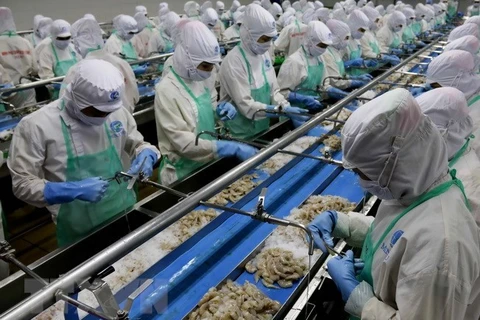HCM City (VNA) – Vietnam’s export of aquatic products maintained a two-digit growth in the first half of 2018 and is forecast to continue growing strongly in the rest of the year despite plunging shrimp prices across the world.
Seafood exports reached a value of nearly 4 billion USD during the period, up 12.3 percent year-on-year, according to the Vietnam Association of Seafood Exporters and Processors (VASEP).
In June, basa fish brought home over 200 million USD, up nearly 33 percent annually, bringing the six-month figure to about 1 billion USD, up 21 percent.
Apart from those to the EU, basa fish exports to other markets remain optimistic, particularly in China and the US.
Thanks to close quality control by the US Department of Agriculture, US-based consumers and rivals have no reasons to boycott Vietnamese basa fish. Moreover, positive signs from other markets, such as in China, also raised basa fish prices considerably.
VASEP statistics showed that shrimp exports went up 7.6 percent year-on-year to top 1.6 billion USD in the year’s first half.
Despite the impact of the EU’s “yellow card” warning on illegal, unreported and unregulated fishing, tuna shipments exceeded 300 million USD during the period, up 13 percent year-on-year. Cuttlefish and octopus exports moved up 13 percent to roughly 300 million USD, while other seafood exports neared 653 million USD, marking a 14 percent increase.
Firms predicted that seafood exports will keep growing over the last half of the year thanks to an increase in demand. A number of domestic processing enterprises have signed contracts to serve major holidays later this year.
Seafood exports to the US, Vietnam’s largest importer, inched up 1.3 percent from last year, reaching 626 million USD, and was followed by exports to Japan, up 4.8 percent with a value of around 600 million USD.
Following the IUU “yellow card” warning, seafood exports to the EU still grew, but only by around 2.7 percent, placing the EU fourth among Vietnam’s major export markets, behind the US, Japan, and China.
With 586 million USD in revenue in the year’s first half, up 16.7 percent annually, China is now the third largest importer of Vietnamese aquatic products.
VASEP General Secretary Truong Dinh Hoe said China is likely to become Vietnam’s largest seafood importer in the near future. Last year, China was ranked amongst the top billion USD seafood export markets in Vietnam for the first time, coming in fourth place with a value of 1.28 billion USD and accounting for 15 percent of the market share.
Over the past five years, Vietnam’s basa fish exports to China have surged 21-31 percent annually.
However, China’s mass purchase of Vietnam’s seafood materials is also harming the supply to domestic processing plants, making it hard for authorities to control the chemical content and quality of seafood materials for export, thus hurting the image and trademark of Vietnamese seafood in China and abroad.
VASEP has recently suggested that the Ministry of Agriculture and Rural Development issue and check quality certificates before goods are shipped to China by road, while inspecting seafood processing facilities to ensure quality.-VNA
Seafood exports reached a value of nearly 4 billion USD during the period, up 12.3 percent year-on-year, according to the Vietnam Association of Seafood Exporters and Processors (VASEP).
In June, basa fish brought home over 200 million USD, up nearly 33 percent annually, bringing the six-month figure to about 1 billion USD, up 21 percent.
Apart from those to the EU, basa fish exports to other markets remain optimistic, particularly in China and the US.
Thanks to close quality control by the US Department of Agriculture, US-based consumers and rivals have no reasons to boycott Vietnamese basa fish. Moreover, positive signs from other markets, such as in China, also raised basa fish prices considerably.
VASEP statistics showed that shrimp exports went up 7.6 percent year-on-year to top 1.6 billion USD in the year’s first half.
Despite the impact of the EU’s “yellow card” warning on illegal, unreported and unregulated fishing, tuna shipments exceeded 300 million USD during the period, up 13 percent year-on-year. Cuttlefish and octopus exports moved up 13 percent to roughly 300 million USD, while other seafood exports neared 653 million USD, marking a 14 percent increase.
Firms predicted that seafood exports will keep growing over the last half of the year thanks to an increase in demand. A number of domestic processing enterprises have signed contracts to serve major holidays later this year.
Seafood exports to the US, Vietnam’s largest importer, inched up 1.3 percent from last year, reaching 626 million USD, and was followed by exports to Japan, up 4.8 percent with a value of around 600 million USD.
Following the IUU “yellow card” warning, seafood exports to the EU still grew, but only by around 2.7 percent, placing the EU fourth among Vietnam’s major export markets, behind the US, Japan, and China.
With 586 million USD in revenue in the year’s first half, up 16.7 percent annually, China is now the third largest importer of Vietnamese aquatic products.
VASEP General Secretary Truong Dinh Hoe said China is likely to become Vietnam’s largest seafood importer in the near future. Last year, China was ranked amongst the top billion USD seafood export markets in Vietnam for the first time, coming in fourth place with a value of 1.28 billion USD and accounting for 15 percent of the market share.
Over the past five years, Vietnam’s basa fish exports to China have surged 21-31 percent annually.
However, China’s mass purchase of Vietnam’s seafood materials is also harming the supply to domestic processing plants, making it hard for authorities to control the chemical content and quality of seafood materials for export, thus hurting the image and trademark of Vietnamese seafood in China and abroad.
VASEP has recently suggested that the Ministry of Agriculture and Rural Development issue and check quality certificates before goods are shipped to China by road, while inspecting seafood processing facilities to ensure quality.-VNA
VNA
























